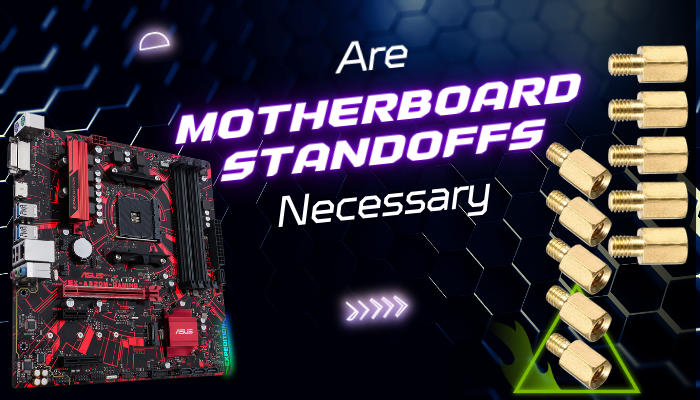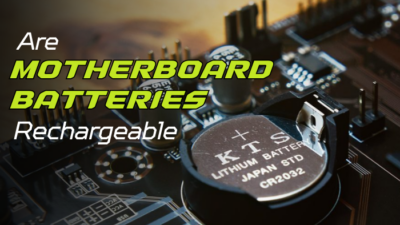Let me guess, you recently got yourself a new motherboard and when you were installing it you came across these standoffs.
Now, you are confused about how important standoffs are in the motherboard installation process.
Are motherboard standoffs necessary?
Yes, there is no doubt that you need motherboard standoffs for any computer system. The good news is that nowadays more and more computer cases come with standoffs that are already built directly onto the case and preinstalled.
You did the right thing coming here as I myself have faced the same confusion before I became a professional IT technician. I have gathered everything you need to know about motherboard standoffs and how necessary they are.
Do grab something to eat, or whatever puts you in the reading mood, and read this entire article so you can get all your doubts eliminated.
Also, check out our separate post on best motherboards for i9-10900K
What Are Motherboard Standoffs?
Motherboard standoffs are the small bits of metal that look a lot like screws. The difference is that the standoffs have an anchor in the place of a head where another screw can be inserted. You usually get these with the motherboard case.
The normal thing to do with a standoff is to screw them onto a case. After this, you put the motherboard on top of the standoffs and screw them tightly.
Here’s a complete guide on how to fix motherboard can’t detect hard drive.
On the other hand, you don’t even need to know which way to screw the standoffs, nowadays. I will discuss more on this in the next section.
So, what is the main reason for motherboard standoffs being so important?
It’s because standoffs have the ability to offer you a spacer between the motherboard and the case that’s electrically safe.
Check out our separate post on how a Motherboard Bottleneck GPU.
Why is this important?
Well, the paneling of the case is more likely to be made of steel which means that if the motherboard was to come in direct contact with the case, it could lead to a short circuit which leads to a dead motherboard.
This short circuit could also destroy other components that are attached to your PC like your CPU, RAM or SSD.
Another thing that can be considered as a bonus is the fact that standoffs actually improve the airflow inside the case even if it is a very slight improvement.
Also, check out our separate post on how to fix motherboard HDMI no signal.
Do Motherboard Standoffs Come With Case?

Also, check our exclusive tutorial on Motherboard Drivers are Necessary.
Many people assume that standoffs come with the motherboard itself but this is definitely not true. Standoffs have always been included with the case because unlike motherboards, standoffs are not standardized and have different sizes.
As I mentioned earlier, you don’t need to worry about knowing exactly how to screw the standoffs and this is because modern-day cases don’t need you to do anything except mounting the motherboard onto the standoffs on the case.
If you end up in a rare scenario where you don’t get the standoffs from both the motherboard and the case or if you simply ran out of standoffs, there’s nothing to worry about.
You can always get extras for all sorts of standoffs at any PC repair store or if you do a lot of online shopping, you can order these online, too.
Where Do You Put Motherboard Standoffs?
The typical method is to install metal standoffs closer to the rear edge and somewhere in the center. The plastic standoffs are usually installed near the edge that is in close proximity to the front of the case.
You are supposed to put the motherboard on top of the standoffs while the screws should go into the standoffs through the motherboard.
I know how nervous you might be feeling if you are a complete beginner so let me explain this in simple words.
Simply open up the case and lay it down so that you are looking down on the case. Insert the mounting screws inside and be sure that they line up properly with the mounting holes for your motherboard. If you follow this, you will be just fine.
While doing this, keep in mind that if you do not use all the required standoffs, your motherboard could flex or even break due to the uneven pressure.
Another point for beginners to consider is that you should never over-tighten the motherboard mounts to the case otherwise you will end up with a stripped mount.
FAQ
Question: What happens if you don’t use motherboard standoffs?
Answer: The motherboard could come into direct contact with the case which means some of your PC components could end up completely fried. The best case scenario is when your PC only stops turning on after a shutdown.
Question: How many motherboard standoffs do you need?
Answer: The exact number will vary from case to case. You just need to keep enough so that the motherboard and case don’t have any contact. Just keep in mind that it’s best to fill up every hole.
Question: What happens if you don’t use all standoffs?
Answer: As long as you installed n the corners and the center, it should be fine. There’s no need for all of them but you should make sure the motherboard doesn’t get in contact with the case.
Question: How many standoffs does ATX motherboard have?
Answer: Generally speaking, if a computer case wants to meet ATX standards, it would have to come with 9 standoffs. Out of these, only 6 standoffs are mostly used. If the case or board is smaller, these numbers will be smaller as well.
Question: Do motherboard standoffs need to be brass?
Answer: No, motherboard standoffs can definitely be made of something else. For example, plastic. However, most of the standoffs you will see will be made of brass and that’s because it can even work as a grounding technique
Question: Can motherboard standoffs be plastic?
Answer: Yes, they can be but you will notice that brass is much more useful than plastic. For one thing, the plastic ones leave your components more vulnerable to ESD or Electrostatic discharge.
Question: Should I remove unused motherboard standoffs?
Answer: It’s a good practice to remove any standoffs that are not in use because if one of these touches the motherboard, they can short a trace to the ground. You might even have to move a few of them around so they are properly aligned with your motherboard’s mounting points.
Final Thoughts
Forgetting to install motherboard standoffs properly could have very negative consequences, like fire hazards or short-circuits, for not just your motherboard, but for all other devices connected to the motherboard.
I hope you finally understand how these tiny components have such a great impact on your system. These standoffs create a space between the case and motherboard that not only makes the case safer to use but also helps with cooling and reducing fan noise.
Check out some of our other posts if you want to get some more of your confusions watered down.




